In the history of Indian architecture, the rock-cut cave architecture enjoyed a place of great significance because these monuments were out of the live rock (stone is not separated from the hill) over centuries. A craftsman cuts caves using primitive technology. They used only hammers & chisel manually. The level of refinement of cave architecture is of an extremely high order.
The cave architecture flourished in North as well as South India. These monuments were patronized by rulers as well as a private citizen. That contribution of individuals as much more in the progress of cave architecture. The cave architecture of India transcends religious boundaries because these monuments belong to Buddhism, Jainism, Shaivism, and Vaishnavism. These are not limited to any particular religion.
Stone Age Caves

The earliest caves in India belong to the Stone Age. Similarly, many caves have been found in Himalayas, Vindhyas & Western Ghats. Bhimbetka caves located in the Raisen district of Madhya Pradesh are the finest example. Caves of this age are natural. These were not cut by mankind. These caves are simple without any ornamentation. They are almost in their natural state. Because of this architecture significance of these caves are negligible.
Mauryan Age Caves
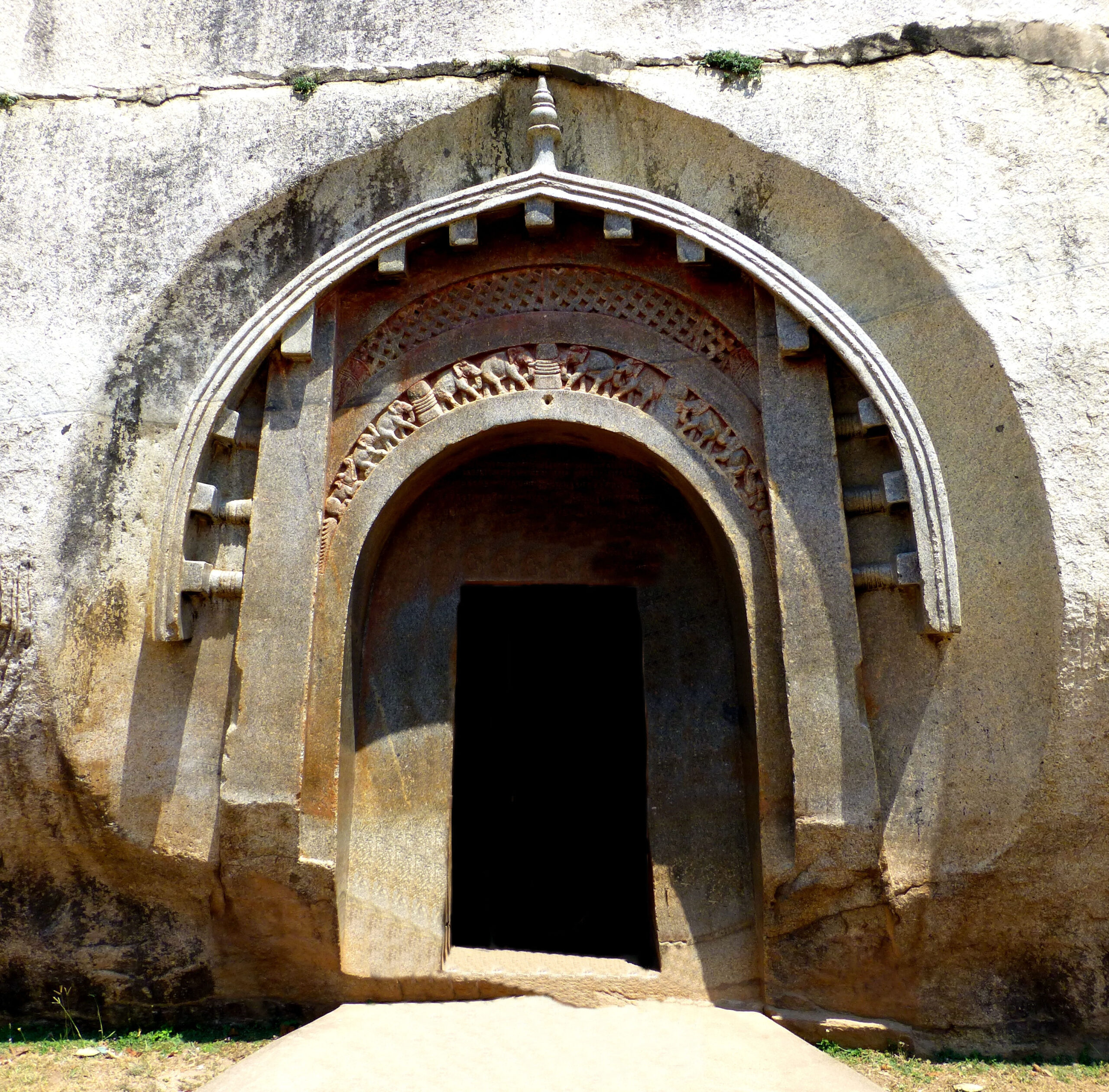
For the 1st time during the Mauryan Age, artificial/man-made caves emerged. These caves were cut during the reign of emperor Ashoka & his grandson Dasharatha. Four caves were cut during the reign of Ashoka in Barabar hills (Gaya district, Bihar) & 3 caves were cut during the reign of Dashratha in Nagarjuni hills (near to Barabar hills, Gaya district).
These caves were donated to the monk of the Ajivaka sect. This sect was founded by Makkhaliputta Gosala (6th century BC), contemporary of Mahavir, both of them lived together for some time. The caves located in Barabar hills are Lomas Rishi Cave, Sudama, Karna Chaupar, and Visva Jhompri.
Caves located in Nagarjuni hills are Vapiya Cave, Gopi Cave, and Vadithi caves. These caves are simple, rectangular rock-cut halls. The roof & doorway are semi-circular in some of the caves. These caves comprise 21 chambers. The front & back chamber. The front portion was used for religious congregation & the back chamber was used for residential purposes by the monks. Interior walls & roofs are polished. This polish is very much similar to polish found on the Ashokan pillar. These worlds famous caves have been described by M. Forster through his book “A passage to India” in which he described the glory of this age.
Post Mauryan Cave Architecture
The cave architecture witnessed the most remarkable progress during the post-Mauryan age. A large number of caves were nut during this period in Eastern as well as western India. Caves of this age are highly ornamented. Curved pillars are found in these caves along the walls & at the entrance. Floral, Geometrical design, animal images & human images were also used in range numbers.
Many of the cave of this age have painted on their walls, roof & pillars. The entrance to the cave is also highly decorated. For the 1st time, a multistoried cave was cut during this age. The tradition of double story cave commenced at Karley & at Ajanta, even triple storied caves were cut.
Caves in Eastern India

In Eastern India, cave architecture flourished in Odisha. A large number of caves are cut in Udaigiri – Khandagiri hills located near Bhuvneshwar. These caves were cut during the reign of king Kharvela (193 BC – 170 BC). These caves belong to Jainism. These are in form of Chaityas & Viharas. Chaitya refers to the place of worship & Vihara refers to the place of residence of monks. Viharas were also used as educational institutions.
There are 18 caves in the Udaigiri hills & 15 in Khandagiri hills. Prominent caves in Udaigiri hills are – Ranigumpha, Ganesh Gumpha, Rosai Gumpha, Hathi Gumpha, Sarpa Gumpha. The most important cave in this is Ranigumpha, because of its double-storied monastery. Hatigumpha cave contains an inscription of king Kharvela. This inscription describes the achievements of the king. It’s one of the most important inscriptions of the ancient age. It informs that king Kharvela organized a successful military campaign against Magadha Empire. He brought back an image of Jaina from Magadha that was carried away by Mahapadamnanda, founder of the Nanda dynasty (193-170 BC). Prominent caves in Khandagiri hills are – Ambika Gumpha, Tentuli Gumpha, Ananta Gumpha & Tatowa Gumpha.
Cave Architect during and post-Gupta Age
In this section, we will discuss Cave architecture during the Gupta Age and after the Gupta age. In the Gupta age, we will learn about Ajanta, Bagha caves architecture and after the post-Gupta Age, we will discuss Ellora caves, elephant caves, etc.
During Gupta Age
The tradition of cave architecture continued during the Gupta Age. Caves of this age are found at Ajanta, Bagha, Udaigiri & Mandargiri. Cave 16, 17, 19 at Ajanta was cut during this age. Bagha is located in the Dhar district of Madhya Pradesh. There are 9 caves at this place. These were cut during Gupta Age. These caves belong to Buddhism.
These were discovered by the F. Danger field in 1818 AD. Udaigiri caves are located near Vidisha in Madhya Pradesh. These caves belong to Vaishnavism & Shaivism. Huge images of Vishnu in Varaha form are found at the gate of some Udaigiri caves. Mandar caves are located in Bhagalpur district, Bihar. These caves belong to Jainism.
Post Gupta & Early Medieval Age
Caves of this age are found in peninsular India at Ellora, Elephanta, Badami/Vatapi & in the Pallava Kingdom.
Ellora Caves
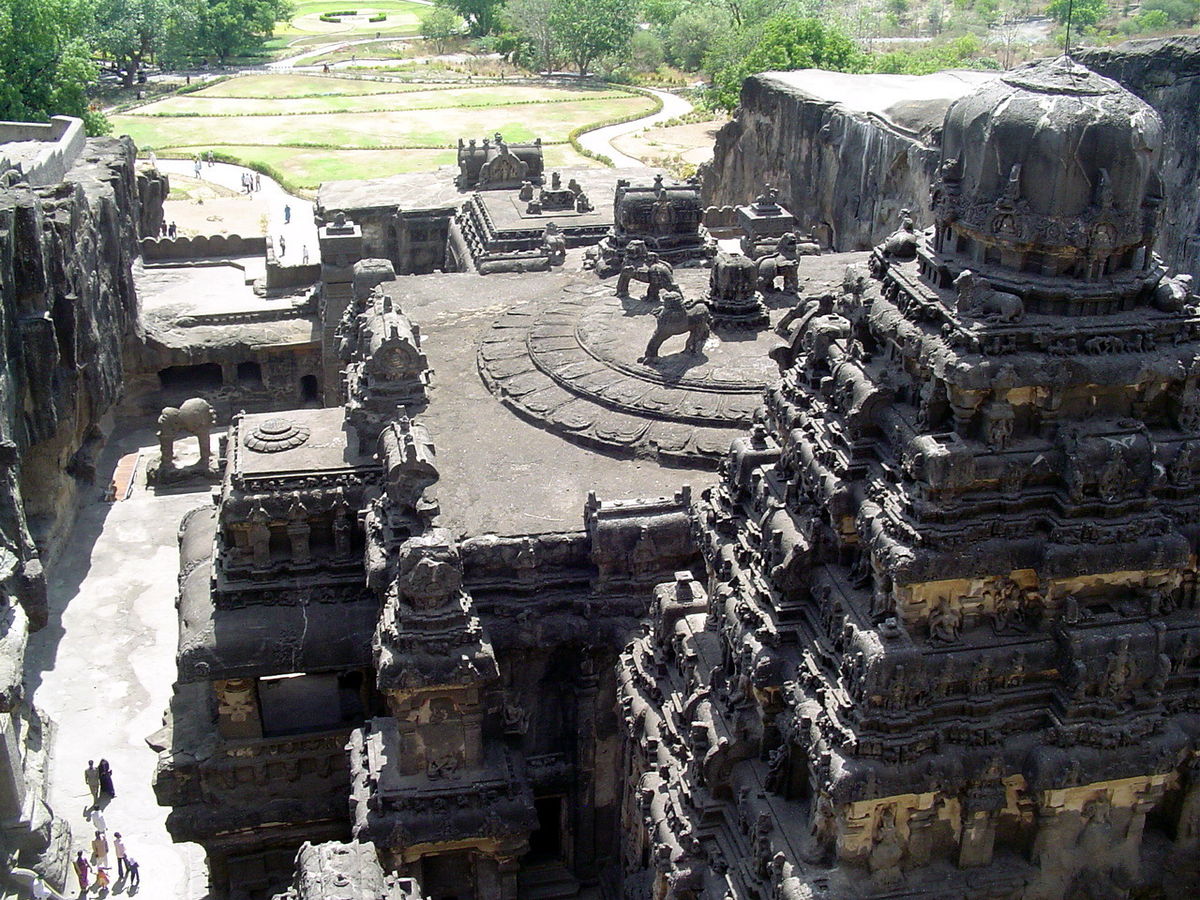
There are 34 caves at Ellora. These caves belong to Buddhism, Jainism & Hinduism. Cave number 1 to 12 belongs to Buddhism. Cave number 13 to 29 belongs to Hinduism. Cave number 30 to 34 belongs to Jainism. These are cut during 600 – 1000AD. These extend to over distance of about 2 km. Ellora caves are the finest example of religious tolerance & liberal progressive outlook of Ancient India because caves belonging to all 3 faiths were cut simultaneously. The followers of all 3 faith work prominently contemporary without any atomicity.
Cave number 10 is Chaitya. This cave has a multistory entrance & pillars at the gate. Cave number 6 has images of the goddess Tara & Mahamayuri. Mahamayuri was similar to Goddess Saraswati; she was a goddess of learning on Buddhism depicted on a peacock. Cave number 12 & 11 are triple storied. Cave number 11 – “Do Taa” – because initially only two stories were known, the 3rd story is in form of a basement discovered in 1876.
Cave number 11 has the images of Goddess Durga & Ganesh along with Buddhist images. Cave number 15 is known as the Dashavtara temple. It is dedicated to God Vishnu. It appears that initially it was planned to be as Buddhist Vihara but later on it was developed as a Hindu temple. These caves have a beautiful image of Nataraja along with various incarnations of Vishnu.
Cave number 16 is most prominent at Ellora. It’s known as Kailasha temple. The cutting of this temple commenced in 760 AD during the region of Rashtrakuta king Krishna I. The work continued for the next 100 years. Craftsman removed more than 2 lacs of material by using their primitive tools. It’s the biggest monolithic structure in the world. Its height is 36.6 meters, the length is 84.1 m & width is 47 m. These temples depict the abode of God Shiva in Kailash Mountain. A large number of image of Shiva in a different form, images of Nandi & Shiva symbol is depicted. There were paintings on the wall of this temple but most of these paintings got damaged at present.
Kailash temple has been cut in Dravidian style though it is monolithic. Cave number 21 is known as Rameshwar cave/temple. It is the oldest among all caves. It has a beautiful image of Ganga. Cave number 25 is known as Kamharadam. It contains a beautiful image of the Sun God in his Chanat at dawn time. Cave number 29 is known as Dhumar leng. Its planning appears to be unusual, it’s in a cross shape.
It contains the image of God Shiva in various forms. Cave number 30 is known as Chota Kailash because its design is similar to Kailash temple. Cave number 32 Indra Sabha. This cave has beautiful. In ancient times Ellora was known as Elapura. These caves were included in the World Heritage site list in 1983.
Elephanta Caves
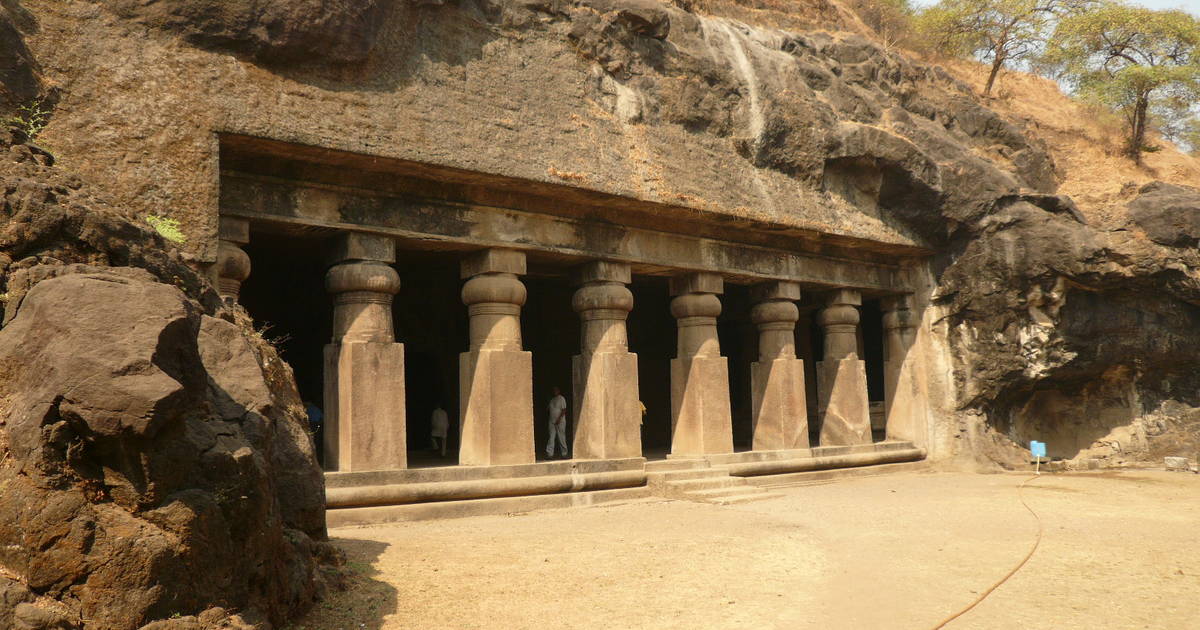
It’s an Island located 10 km from the Mumbai coast. These caves were originally known as “Gharapuri”. The name elephant was given by the Portuguese. Portuguese reached here in 1534. At that time there was a huge image of an elephant on this island near the coast looking toward the sea. The name elephant was given because of this image. At present this image is located in the Lawn of Bhau Dajilad museum. (Earlier known as Victoria & Elbert) museum at Bhaikula, Mumbai). This lawn is known as “Jijamata Udyan (Victoria Garden). There are 7 caves at Elephanta. Out of these 5 are Hindu & 2 are Buddhists.
These caves were worshiped by locals before the establishment of Portuguese control over the Island. The Portuguese didn’t allow locals to enter into caves. Hindu caves are dedicated to God Shiva & Vishnu. Beautiful Shiva images in Trimurti, Maheshmurti, Ardanarishwar & Uma – Maheshwar form are found in this cave. These caves were cut during the 5th century to 8th century AD. These caves were included in UNESCO’s World Heritage Site list in 1987.
Badami Caves/Vatapi
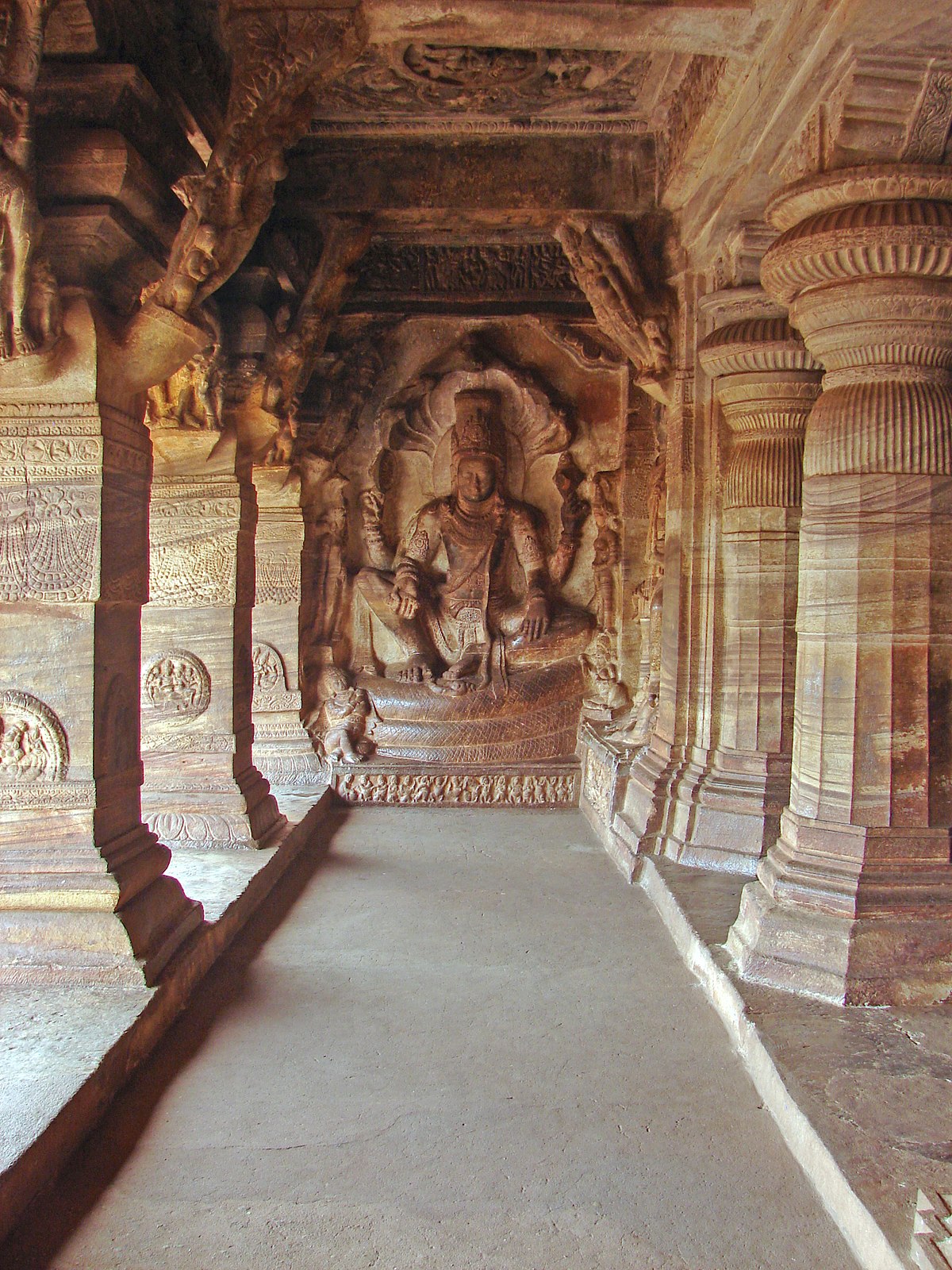
These caves cut during the reign of Chalukya during the 6th- 7th century, Badami was the capital of Chalukya. 8 Hindu & 1 Jaina caves are located here.
Pallava Cave
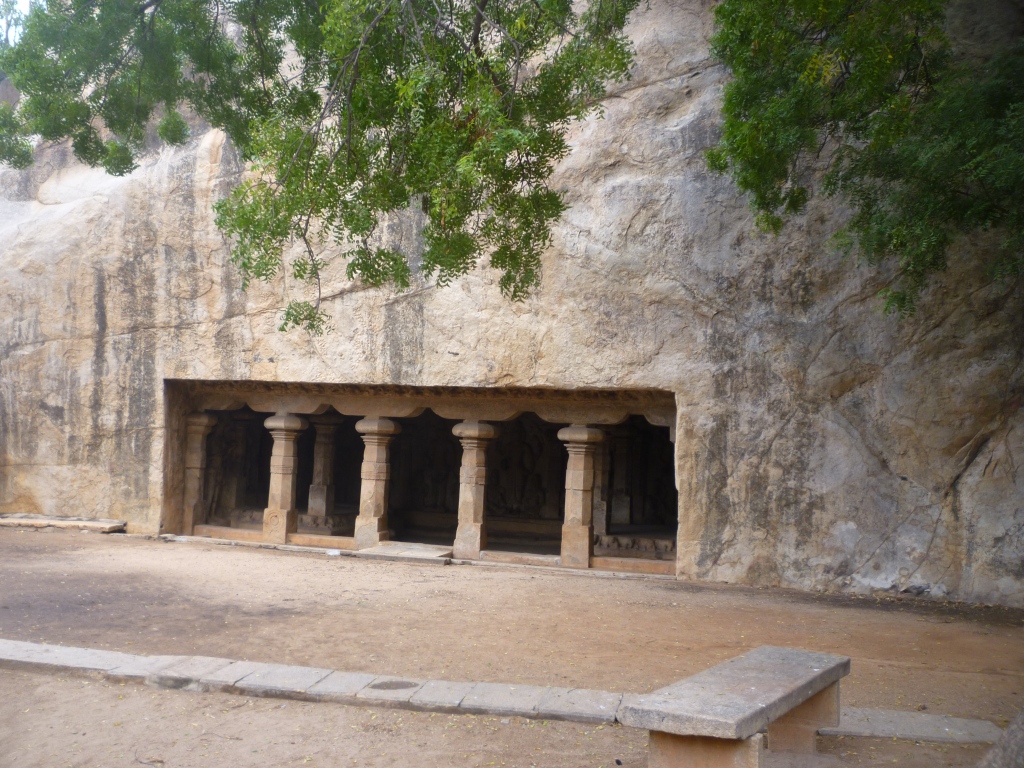
Pallava ruled in Tamil land with its capital at Kanchipuram from the 4th century to the middle of the 9th century. Cave architecture was patronized by King Mahendra Varmana 1 & Narasimha 1 in the 7th century. Mahendra Varmana 1 was a great builder. His title was Chaityakari. He started the tradition of cutting the caves. Caves cut during his reign are found at Mahendravad & Pallavavaram (Tamilnadu).
Mahendra Vishnugriha, Mandapa, located at Mahendravadi & Panchapandava Mandapa (Pallavavaram) are the finest example of cave architecture belonging to the reign of Mahendra Varmana-1. These caves are known as Mandapas/cave temples. They represented the Mahendra style of architecture. Caves cut during the reign of Narsimha-1 are located at Mahabalipuram.
Adivaraha Mandapa & Ramanuja Mandapa are the finest examples. These caves belong to the Mamalla style of temple architecture, Mamalla was the title of King Narsimhna-1. The caves belonging to the Mahendra style are less ornamented & much less refined when compared with the caves of the Mamalla style.
The pillars cut in the caves of Mahendra style are smaller & thicker whereas the pillars cut in Mamalla style are higher, finely carved. These caves are rectangular halls. The back wall has one or more rooms. These rooms were used by monks for residential purpose & halls used for religious gatherings & worship. The rows of the pillar were cut along the walls as well as in front of the gate. The images of doorkeepers were placed near the main gate of the cave on both sides.
Caves in Western India
In Western India, large numbers of caves are cut in Maharashtra state in Western Ghat. These caves belong to Buddhism. They are in form of Chaityas & Viharas. Buddhist Chaityas were known as Layana/Lena in Sanskrit literature. These caves are found at Karley, Nashik, Junnar, Pitatkhora, Bedsa, Bhaja, Kanheri, Kondana in Western India Karley is located in the Pune district. One Chaitya & 3 Viharas are located here.
The Karley Chaitya is the most beautiful among all Chaityas. It was cut by Bhootpal Srehti (Banker) of Vaijanti in 2nd century AD during the reign of Satvahana king Pulameyi II as informed by an inscription found on the walls of these Chaityas. Double story cave was cut for 1st time at Karley.
At Nashik, there are 17 caves out of which one is Chaityas & 16 are Viharas. These Chaityas are known as Pandulena. It is believed to be having used by Pandava. It was cut in 1st century AD. This Chaitya has a gallery of music. There are benches near the stupa. It is believed that magicians used to sit there to play instruments. There are 130 caves at Junnar. It is the largest cave complex in India.
Kanheri is located near Borivali, Mumbai. In ancient times it was known as Krishnagiri. Bedsa caves & Kondana caves exhibit the influence of wooden architecture. The pillars used in these caves tapper (wider at the bottom) from bottom to top. Bedsa is located in Poona district & Kondan is located in Raigarh district. In the Buddhist text Mahamayuri, its mentioned as Petangalya (13 caves). Ajanta caves began to be cut during this age.
Ajanta Cave
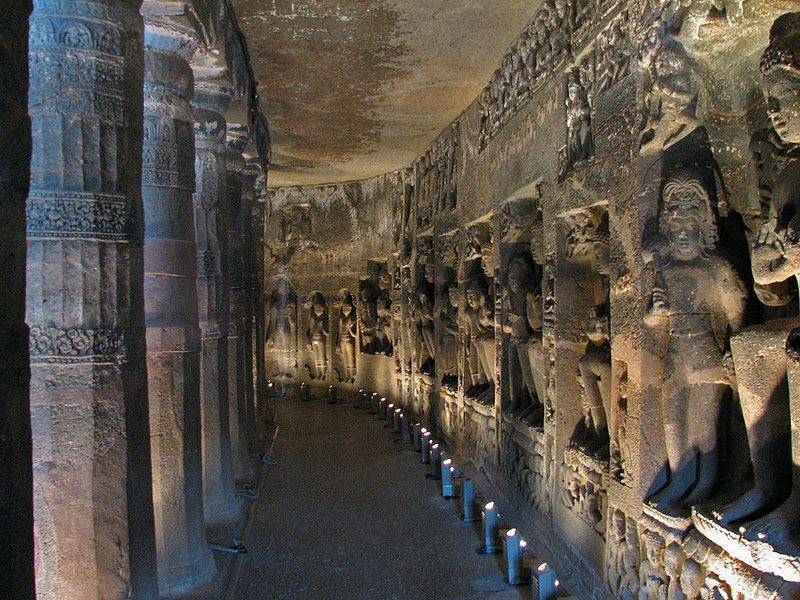
There are 30 caves. While 29 are in a finished state but one cave seems to be incomplete. Ajanta caves are located in Aurangabad, Maharashtra. These are Buddhist caves; there are 5 Chaityas & 25 Viharas. These caves were cut from 2nd century BC – 8th century AD over 1000 years. Craftsmen worked generation after generation to cut these caves. These craftsmen were patronized by local rulers & merchants passing through the area.
Ajanta was located on the main trade route connecting North India to ports of the Western coast. The merchants used to stop at this place to take rest. They used to sit in the company of Buddhist monks to get knowledge & donations were made by them for cuttings of Chaitya & Vihara. Cave number 10 is the oldest & number 26 is last among finished cave.
Cave number 16, 17, 19 belong to the Gupta period. Early caves belong to Hinayana & later caves belong to Mahayana. Cave number 16 is the most beautiful. Cave number 16 & 17 were cut by Varahdeva. He was a feudatory (subordinate ruler) of Vakataka king Harisena (475-500AD). This information comes from an inscription found on walls of caves.
The Ajanta caves were discovered by Captain John Smith in 189 AD. He was an officer with the Madras army. While he was on hunting expedition. He came across these caves. In 1824, James Alexander made the world aware of these caves. He published details of these caves in the journal of Royal Asiatic Society. Ajanta caves were included in UNESCO’s world heritage site list in 1983.
